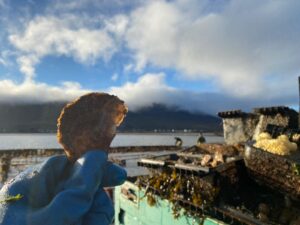Work to enhance native oyster fisheries in Clew Bay using innovative aquaculture and restoration practices underway

BIM extends its thanks to Clew Bay Oyster Co-op for organising their members and TY students from local schools to help work on the native oyster nursery in Murrisk, Clew Bay, Co. Mayo this month. This initiative highlights the importance and benefits of integrating complementary aquaculture and restoration practices in the management of marine ecosystems.
Marine ecosystems, particularly native oyster reefs, play a crucial role in providing essential ecosystem services such as coastal protection, carbon sequestration, water filtration, and supporting fisheries production. By using aquaculture techniques to support restoration efforts, we are not only enhancing the resilience of these ecosystems but also contributing to climate change mitigation and adaptation.
Since 2020, BIM, in partnership with the Marine Institute and industry stakeholders, has been actively involved in enhancing European flat oyster populations through the application of complementary aquaculture and restoration practices. The primary goal of this collaborative work is to support the restoration and management of existing native oyster fisheries, using innovative tools to facilitate compliance with the proposed EU Nature Restoration Regulation.
Through the establishment of spatting ponds and the careful management of environmental parameters, we have successfully reared spat on shell under different nursery scenarios. Last year, we broadcast stock onto protected beds and closely monitored their growth and survival. This year, our focus is on investigating the potential advantages of bottom culture systems in combating the parasitic rhizarian Bonamia ostreae, which poses a threat to oysters above 60mm in size.
This ongoing work is made possible through the support of the European Maritime Fisheries and Aquaculture Fund and the Government of Ireland. We are committed to leading the restoration and sustainability of native oyster fisheries.
